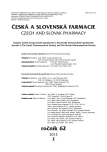Evaluation of the influence of sterilization method on the stability of carboxymethyl cellulose wound dressing
Authors:
Jan Muselík; Lenka Wojnarová; Ruta Masteiková; Tomáš Sopuch
Authors‘ workplace:
Veterinární a farmaceutická univerzita Brno, Farmaceutická fakulta, Ústav technologie léků
1; Lékárna Sfinx, Brno
2; Holzbecher spol. s r. o. barevna a bělidlo Zlíč, divize Holzbecher Medical
3
Published in:
Čes. slov. Farm., 2013; 62, 95-98
Category:
Original Articles
Overview
Carboxymethyl cellulose, especially its sodium salt, is a versatile pharmaceutical excipient. From a therapeutic point of view, sodium salt of carboxymethyl cellulose is used in the production of modern wound dressings to allow moist wound healing. Wound dressings must be sterile and stable throughout their shelf life and have to be able to withstand different temperature conditions. At the present time, a number of sterilization methods are available. In the case of polymeric materials, the selected sterilization process must not induce any changes in the polymer structure, such as polymer chains cleavage, changes in cross-linking, etc. This paper evaluates the influence of different sterilization methods (γ–radiation, β–radiation, ethylene oxide) on the stability of carboxymethyl cellulose and the results of long-term and accelerated stability testing. Evaluation of samples was performed using size-exclusion chromatography. The obtained results showed that ethylene oxide sterilization was the least aggressive variant of the sterilization methods tested. When the γ-radiation sterilization was used, the changes in the size of the carboxymethyl cellulose molecule occurred. In the course of accelerated and long term stability studies, no further degradation changes were observed, and thus sterilized samples are suitable for long term storage.
Keywords:
carboxymethyl cellulose – sterilization – stability testing – size exclusion chromatography
Sources
1. Wiegand C., Abel M., Ruth P., Wilhelms T., Schulze D., Norgauer J., Hipler U.-C. Effect of the sterilization method on the performance of collagen Type I on chronic wound parameters in vitro. Biomed. Mater. Res. Part B 2009; 90B, 710–719.
2. Labarre D., Ponchel G., Vauthier C. Biomedical and Pharmaceutical Polymers. 1st ed. London: Pharmaceutical Press 2010.
3. Bushell J. A., Claybourn M., Williams H. E., Murphy D. M. An EPR and ENDOR study of γγ- and ββ-radiation sterilization in poly(lactide-co-glycolide) polymers and microspheres. J. Control. Release 2005; 110, 49–57.
4. Choi J. I., Lee H. S., Kim J. H., Lee K. W., Lee J. W. Seo S. J., Kang K. W., Byun M. W. Controlling the radiation degradation of carboxymethylcellulose solution. Polym. Degrad. Stabil. 2008; 93, 310–315.
5. Fei B., Wach R. A., Mitomo H., Yoshi, F., Kume T. Hydrogel of biodegradable cellulose derivatives. I. Radiation-induced crosslinking of CMC. J. Appl. Polym. Sci. 2000; 78, 278–283.
6. Liu P., Zhai M., Li J., Peng J., Wu J. Radiation preparation and swelling behavior of sodium carboxymethyl cellulose hydrogels. Rad. Phys. Chem. 2002; 63, 525–528.
7. Lee H. S., Choi J. I., Kim J. H., Lee K. W., Chung Y. J., Shin M. H., Byun M. W., Shin M. G., Lee J. W. Investigation on radiation degradation of carboxymethylcellulose by ionizing irradiation. Appl. Radiat. Isotopes 2009; 67, 1513–1515.
8. Choi J. I., Lee H. S., Kim J. H., Lee K. W., Chung Y. J., Byun M. W., Lee J. W. Effect of electron beam irradiation on the viscosity of carboxymethylcellulose solution. Nucl. Instrum. Meth. B 2008; 266, 5068–5071.
9. Vetchý D., Frýbortová K., Rabišková M., Häring A. Testování stability léčivých přípravků. Chem. Listy. 2006; 100, 24–29.
Labels
Pharmacy Clinical pharmacologyArticle was published in
Czech and Slovak Pharmacy

2013 Issue 2
Most read in this issue
- Evaluation of the influence of sterilization method on the stability of carboxymethyl cellulose wound dressing
- Prolegomenon of the Czech pharmacognosy: 21st century
-
Physiological aspects of lipoxygenase in plant signaling systems
Part I. Octadecanoid pathway - Influence of the degree of substitution on the absorptivity of acidic carboxymethyl cellulose in the form of nonwoven fabric
